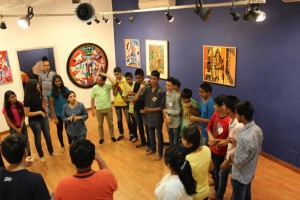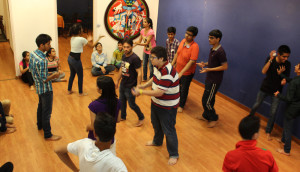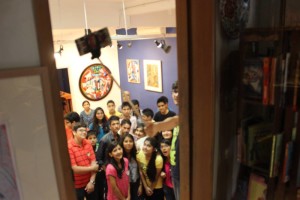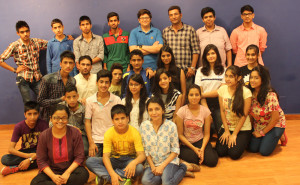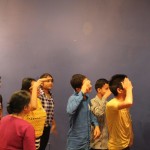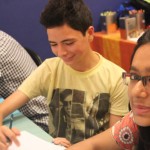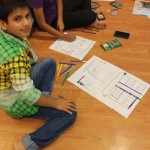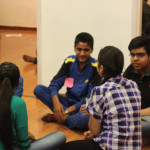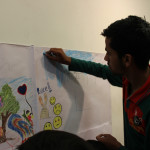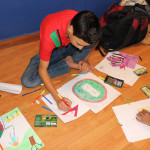Trepidation. Curiosity.
‘Whose paintings are those?’ ‘Where do we sit?’ ‘ When do we start?’
The eighth session of the Dialogue for Peace program started off with shy smiles, handshakes, whispers. Eleven students from the Kashmir valley and eleven from Lakshmipat Singhania School gathered at The Seagull Foundation for the Arts bright and (relatively) early for day one of a seven day long workshop.
Dialogue for Peace, a program initiated in the year 2011, brings together youth from Kashmir and Kolkata, attempting to understand differences between two groups from the same country. It creates a space for learning, thinking and building ties that last.
Seated in a circle, we started off with a round of introductions. These introductions involved the participants introducing themselves with their name as well as a name that would be theirs through the duration of the workshop. This not only served to dispel whatever ideas that can be associated with names, but also served as a great icebreaker.
After everyone had a ‘workshop ke liye’ name, we played a high-octane ball passing game. Great fun, this helped us remember the new names, and provided much hilarity as most of us forgot the names almost immediately. After the game all the participants made badges for themselves—which had their new names written on it. Some interesting shapes and a slowly developing sense of camaraderie was seen by the time we took our first break.
A culturally rich country like India has no dearth of music. Just like literature, music evokes memories and very often goes a long way in moulding our identities. The aim of the next activity was to exchange songs in pairs, thereby creating new memories based on music. Initial shyness overcome, participants heard and made every effort to learn songs in completely new languages—Kashmiri, Marwari, Gujarati and Bengali. Familiar tunes of some Bollywood songs, laughter and jokes could be heard during this session.
The participants then shared the songs that they exchanged (with some prompting from their partners). Finally, a group of very talented boys from Kashmir taught the group the first two lines of a Kashmiri song, and the group from Kolkata, in turn taught them Ekla Cholo Rey.
Share your story. Make eye contact! Trust in your partner!
The next activity involved the group sharing their ‘Jeevani’—their story, in pairs and then with the larger group. Participants were encouraged to go beyond just the standard questions, and try to really get to know their partner—their likes and dislikes, motivations, regrets, triumphs and what makes them who they are.
The third day began with the children assembling at the Seagull office by ten. The previous day had been devoted to a city tour—the participants visiting Kumartuli, the Marble Palace, Jorasanko and the Victoria Memorial amongst other places.
We began the day with an exercise that involved the participants walking around in the space provided, without making eye contact or any contact for that matter with their fellow participants—thus creating a space and path for oneself. It started off with the participants walking in a group, only slowly developing the confidence to create that new path for themselves. Participants enjoyed this exercise, although the instruction of being quiet through the exercise fell on deaf ears, giggles could be heard through out!
Taking the exercise to another level, the participants were then asked to walk around the space making eye contact with all those encountered along the way while all the time making sure not to clash with each other. This became rather challenging when Megha instructed the group to increase their speed and gradually go on to running !
Warm up done, the group was divided into pairs and asked to share their 10-year plan—what they want to become, how they plan to achieve their goals and changes (if any) that they want to bring about in their environment.
Post a well deserved juice and biscuit break, the discussion moved onto the issues of opportunities and equality. The fact that we are all born equals and it is how we deal with the harsh reality that we do not all get the same opportunities that makes us who we are. Setbacks affect all of us without discrimination, and if one is discerning enough then setbacks can be seen as stepping stone to something bigger and better.
Sharing of 10-year plans soon got underway. Fashion design, medicine and the civil services were part of some of the 10-year plans. One of the participants from Kashmir said that he wanted to become a singer, something that might be difficult because of certain restrictions imposed by his religion. He also wants to build a free school for the poor. Many of the participants shared their plans for ‘doing’ for others—whether it be building an old age home, becoming a cardiologist to treat the poor, becoming a civil servant to free their state from problems and deal with issues like strikes (something that we see so commonly these days) which hamper education, because staying at home for so many days is no fun; child labour and freedom for girls.
The group went out for dinner together after the workshop. ‘ Mazaa aa gaya!’ was the refrain the day after, when asked how the outing was.
Anubha Fatehpuria, theatre personality and resource person took over the workshop from Megha on day 4 which started with a warm up exercise which involved the children being separated into randomly selected pairs and throwing a ball back and forth (‘gently, said Anubha, ‘give it like a gift’) while maintaining eye contact. The same exercise was carried out again—except this time one person in the pair would have his or her eyes closed. The idea was to ‘give’ the ball in a way that made sure the partner with closed eyes was able to catch it. After the exercise, Anubha asked the participants how they felt.
‘ We have to be alert’. ‘ It wont do to be lazy!’
One participant said that trust between the partners built up slowly, while another said that that trust was already there. This exercise (done every day for the remaining days of the workshop) was done to build trust, to build teamwork, hand eye coordination and most importantly to establish that to ‘enable’ the other can be truly empowering.
The group then moved onto drawing out their 10 year plans. At first, there was a lot of ‘kaise kare?’ and ‘I don’t know how to draw’, but with minimal instructions and complete freedom to represent their future plans the way that they wanted, the participants really got into the swing of things.
A version of dumb charades was played, except this involved one person in a pair whispering a little story they had thought of on the spot which the partner would act out to the whole group and get them to guess the story. Through the incredibly lively atmosphere this game brought about it was hard not to notice the recurring theme of death and violence in the stories of both the Kashmiri and Kolkata children. Hilariously enough, the other trope that ran through the stories is the need to not litter and use a dustbin instead.
After a leisurely lunch, Anubha brought out a series of posters by Seagull Books designer Sunandini Banerjee and asked the children to spend some time thinking about how they interpreted these images. There was initial hesitation as these images were collages that communicated a ‘sense’ instead of a neatly explainable narrative. The children initially struggled with moving past literal descriptions of the composition of the images to coherent interpretations, but some touching and articulate analysis emerged by the end of the session.
The arguments that were beginning to crop up between children about conflicting interpretations were used as a ‘teaching moment’ by Anubha to speak about the need to accept the validity of different ways of thinking, and to realise that one’s own thoughts while important personally, ought not to be privileged as the ‘truth’.
The evening ended with everyone gathering in front of the camera, beaming, in what is nowadays called a ‘groupfie’.
Day five began with warm ups followed by the completion of the previous days drawings. After a break for lunch, we discussed each of the drawings.
‘ Why haven’t you drawn any clothes for boys?’ one of the aspiring fashion designers was asked.
‘ Should we put aged relatives into old age homes, and if yes, why?’ This question, stemming from one of the drawings, lead to a short discussion on familial duties.
One of the participants wrote ‘Hate the sin and not the sinner’ on his chart. The basic point that the participant was making was that if someone does something ‘wrong’, for instance, stealing, then immediate punishment or ostracization is not the answer. The person who has committed the crime must be spoken with, a dialogue created whereby he/she is made aware of why it is wrong. This sparked a long discussion on religion, the exact meaning of the word ‘jihad’ and what it has morphed into—public perception and what it is based on. The difference between the two words ‘Gunaah’ and ‘Galti’, sometimes used interchangeably and without paying attention to the implications behind the word was also discussed.
The evening was spent playing outdoor games.
Day 6 began with warm ups. The ball game was somewhat chaotic when played with the whole group, but in pairs, it worked much better than in the previous days. Anubha did an extensive feedback session after the game, talking about coordination and development of teamwork. The next exercise involved the participants divided into groups of four or five. Each group was invited to draw something (the instruction given was to draw anything—whatever they wished) on chart paper that was pasted on the wall. While one group was busy with the artwork, the rest worked on building a 10-minute performance based on each of their 10 year plans. This activity showed an interesting synergy, with some groups using paper and pen to jot down ‘scripts’, while others concentrated completely on adding their art to the wall. Each group was told to develop their new art based on what was already on the wall. In the early days of the workshop there was a certain lack of team spirit, but naturally. During this activity, within the groups as well as in the larger group, there was a clear sense of that spirit. Each participant seemed comfortable in being just himself or herself. After lunch, each group presented their skit.
The final day of the workshop saw each participant discuss what they had learnt from the workshop, what they thought was special—not just about what was done as part of the activities, but otherwise also, what they learned, and what they think their contribution was. Not to be judgmental, being grateful for what we have, giving due respect to others views, as well as a few lines of a Kashmiri and a Bengali song were some of the many things the participants learnt!
The end of the day and the workshop meant saying goodbye. Phone numbers and email addresses were exchanged with promises to stay in touch. Perhaps lasting friendships were made. But as one of the participants said, ‘this workshop has taught me things that would have taken teachers years to teach me’.
– Paroma Sengupta, Joyeeta Dey

